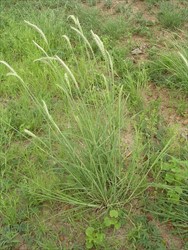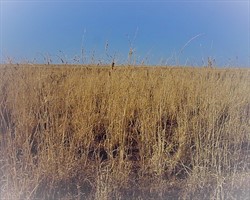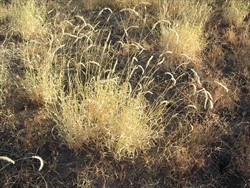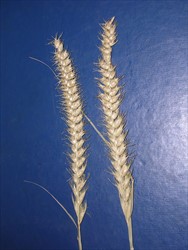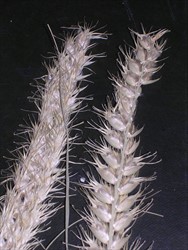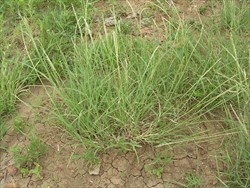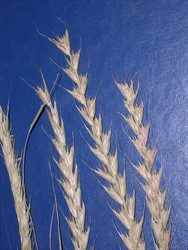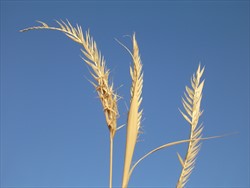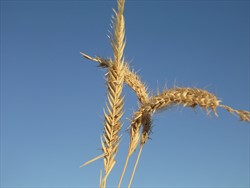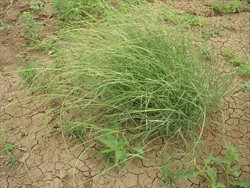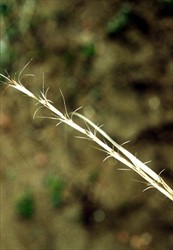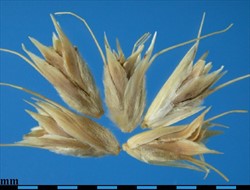Astrebla spp.
Tropical Forages
Astrebla elymoides F. Muell. ex F.M. Bailey
Astrebla lappacea (Lindl.) Domin
Astrebla pectinata (Lindl.) F. Muell.
Astrebla squarrosa C.E. Hubb.
Subordinate taxon:
Astrebla pectinata (Lindl.) F. Muell. var. curvifolia F.M. Bailey
A. lappacea: Basionym: Danthonia lappacea Lindl.; Astrebla triticoides (Lindl.) F. Muell.; Danthonia triticoides Lindl.
A. pectinata: Basionym: Danthonia pectinata Lindl.
Family: Poaceae (alt. Gramineae) subfamily: Chloridoideae tribe: Cynodonteae.
Strongly tufted perennial grasses growing to 1 m tall, culms erect or ascending, arising from scaly bases. Rhizomes short or absent. Ligule a ciliolate membrane or fringe of hairs; leaf blades rolled in bud, narrow. Inflorescence a terminal spike or spike-like raceme, solitary or paired. Roots wiry, dual system comprising shallow roots to utilise surface moisture from lighter rainfall and a deep (>200 cm) system to access subsoil moisture.
Species
A. elymoides (hoop Mitchell): tussock to 50 cm. Stems thin, palatable. Leaf blades linear, attenuate, 12‒35 cm × 0.3‒0.5 cm, glabrous, glaucous, surface ribbed, margins scaberulous, not curling as plant hays off. Spike-like racemes solitary, 12‒35 cm long, narrow, straight, or arcuate, hooping (weeping) towards the ground when mature. Spikelet >4 mm wide, appressed to rachis.
A. lappacea (curly Mitchell): tussock to 50 cm, erect, or decumbent. Stems thin, palatable. Leaf blades linear-oblong, acute, 10‒20 cm × 0.4‒0.5 cm, mostly glabrous, glaucous, curling distinctly as plant hays off. Spike-like racemes single or paired, straight or slightly arcuate; unilateral, 5‒30 cm long, usually held within the foliage. Spikelet >4 mm wide, bristly and loosely arranged along the seed head in an alternate pattern.
A. pectinata (barley Mitchell): tussock to 80 cm. Stems coarse, moderately palatable. Leaf blades linear, attenuate, 7.5‒25 cm × 0.3‒0.6 cm, flat, glaucous, often twisted, surface ribbed, sparsely pubescent with tubercular-based hairs; margins scaberulous. Spike-like racemes single, straight, 4‒13 cm long, held above foliage on long, erect culm. Spikelet >4 mm wide, tightly packed in 2 distinct rows against straight rachis.
A. squarrosa (bull Mitchell): tussock to 100 cm. Stems coarse, relatively unpalatable. Leaf-blades 15–30 cm × 0.3–0.6 cm, scabrous, rough adaxially, margins scaberulous; distinct, whitish mid-vein on the upper surface. Racemes single, unilateral, straight, 7‒18 cm long, Spikelets >4 mm wide, long silky hairs at base, prickly by virtue of distinct hooks at end of awn.
English: A. elymoides: hoop Mitchell grass, slender Mitchell grass, weeping Mitchell grass, wire Mitchell grass
A. lappacea: curly Mitchell grass, common Mitchell grass, wheat Mitchell grass, wheat-ear Mitchell grass
A. pectinata: barley Mitchell grass
A. squarrosa: bull Mitchell grass, wheat-ear Mitchell grass
Native:
Australasia: Australia – A. lappacea, A. pectinata (New South Wales, Northern Territory, Queensland, South Australia, Western Australia)
– A. elymoides, A. squarrosa (New South Wales, Northern Territory, Queensland, Western Australia)
Forage
Valuable native pasture over large areas on clay soils of arid northern and mid-latitude Australia. Acts as standing hay preserved by the dry atmosphere and absence of rainfall during the cool dry season. Winter rain in southern Astrebla grasslands leads to fungal blackening of the dry leaf and deterioration of nutritive value.
Environment
Seed has been harvested to restore Mitchell grasslands after cropping. Astrebla pectinata seed advertised for sale in India.
Soil requirements
Native of heavy cracking clay soils in the arid zone of northern Australia, usually with high pH and free limestone. Some tolerance to salinity.
Moisture
Best development occurs in areas receiving between 250 and 550 mm annual rainfall. Very drought-tolerant due to their robust root system, although many plants die in extremely dry periods. A. elymoides is found on moister depressions; the coarse A. squarrosa is dominant in seasonally flooded country usually in northern Australia; A. pectinata is susceptible to flooding and is common in more arid areas where soils do not crack as severely; and A. lappacea is more common in eastern Mitchell grass downs of Queensland.
Temperature
They produce most of their growth in the warm season, requiring temperatures between 25 °C and 35 °C for optimum germination and growth. They make limited growth following effective winter rainfall, but no growth below 15 °C. Their natural environment extends from about 18° to 28°30' S and to 1,000 m asl. A. pectinata is susceptible to frost. Growth has usually ceased before frosts are experienced because summer soil moisture is usually exhausted.
Light
Full sunlight.
Reproductive development
Flowering is independent of photoperiod, occurring at almost any time of year in response to rainfall.
Defoliation
Astrebla spp. respond well to moderate grazing or cutting which tends to stimulate tillering and seed production. As they age, both the number and size of inflorescences are reduced, although cutting and irrigation may help to promote new growth. Astrebla spp. are generally tolerant of heavy grazing, although heavy grazing during prolonged drought can result in tussock death. Large scale seedling recruitment is rare.
Fire
Mitchell grass is rarely burned, being too valuable as a reserve of feed in an arid climate. However, it will recover well from fire in the absence of grazing following rain.
Guidelines for establishment and management of sown forages.
Establishment
Astrebla spp. are not easy to establish from seed, and sowings must be made on a full profile of soil moisture after a fallow. Seed can be sown into a seedbed or oversown and trampled in by livestock.
Fertilizer
While responses to nitrogenous fertilizer have been obtained, the use of any fertilizer on an Astrebla sward would not be economical in the arid environments where it grows.
Compatibility (with other species)
Robust tussocks growing in an arid zone result in strong competition, but the inter tussock spaces may be occupied by other grasses (perennial species Aristida spp., Dichanthium spp.and annual species of Iseilema, Dactyloctenium and Panicum). Some native legumes (e.g. Glycine spp. and Indigofera spp.) co-exist and a large range of C4 dicotyledoneous species.
Winter rainfall in more southernly regions results in growth of a wide range of C3 forbs.
Companion species
Desmanthus spp. in lower latitudes, and in the higher latitudes with more winter rainfall, Medicago spp. have naturalized.
Pests and diseases
No information available.
Ability to spread
Large scale seedling recruitment is rare but localised spread does occur when seed is present.
Weed potential
Low.
Nutritive value
Moderate nutritional value, often limited by low available soil nitrogen after a wet year.
Palatability/acceptability
Mitchell grasses are not particularly palatable during the wet season. Livestock preferentially select other accompanying species during the summer growing period. However, the Mitchell grasses retain their leaf during the dry season and are eaten then (there being little other feed). Feeding value varies among the species, with A. elymoides and A. lappacea being more acceptable to livestock in the green state than the other two species. Winter rainfall events sometimes experienced in southern Astrebla grasslands lead to deterioration of nutritive value.
Toxicity
A fungus (Corallocytostroma spp.) sometimes found on the stems of Mitchell grass in the Kimberley Region of northern Western Australia has caused ‘black soil blindness’. Up to 5% of stock grazing affected Mitchell grass may die. The fungus is a hard rough body about 10–20 mm diameter and grows on the grass stem at a node or axillary shoot.
Dry matter
Yields of 2 t/ha are common in well grazed pastures during good seasons. Under good conditions of moisture and N fertility, A. lappacea can produce over 6 t dry matter/ha in a season.
Animal production
Highly variable depending on rainfall.
Astrebla spp. are autogamous, and although hybrids do occur, they are sterile. 2n = 4x = 40 in A. lappacea and A. pectinata.
Flowering and seeding is triggered by a minimum of 50‒75 mm of rainfall in one rainfall event, with seed ripening 5‒6 weeks after that rainfall. Seed dispersal is rapid and usually complete within 7 weeks. Fresh seed is dormant for 8 months after ripening.
Natural stands of Astrebla produce abundant seed heads that can be harvested with conventional headers or with brush harvesters. Seed yields have varied from 50 to 100 kg/ha (naked caryopses) for wild stands, and spikelet yields of up to 200 kg/ha in curly Mitchell grass (Astrebla lappacea) have been measured. Seed production can be improved 3-fold by applications of 100‒150 kg/ha N through increasing the number of inflorescences per square metre and the number of spikelets per inflorescence.
Diuron is registered in Australia for control of selected broadleaf and grass weeds in seed crops of A. lappacea, applied as a single pre-emergent or early post- emergent treatment to weeds only.
- Very drought tolerant.
- Tolerant of heavy grazing.
- Grow well on heavy cracking clay soils.
- Good stand-over feed.
- Not very palatable.
- Generally restricted to alkaline clay soils with summer dominant rainfall.
Jubb, T.F., Main, D.C., Mitchell, A.A., Shivas, R.G. and De Witte, K.W. (1996) Black soil blindness: A new mycotoxicosis of cattle grazing Corallocytostroma-infected Mitchell grass (Astrebla spp). Australian Veterinary Journal 73:49–51. doi.org/10.1111/j.1751-0813.1996.tb09964.x
Milson, J.M. (2000) Pasture plants of north-west Queensland. Information Series QI00015. Queensland Department of Primary Industries, Brisbane, Australia.
Orr, D.M. (1975) A review of Astrebla (Mitchell grass) pastures in Australia. Tropical Grasslands 9:21–36. bit.ly/39cVSEt
Orr, D.M. and Holmes, W.E. (1984) Mitchell grasslands. In: Harrington, G.N., Wilson, A.D. and Young, M.D. (eds) Management of Australia’s Rangelands. CSIRO, Melbourne, Australia.
Orr, D.M. and Phelps, D.G. (2013) Impacts of level of utilisation by grazing on an Astrebla (Mitchell grass) grassland in north-western Queensland between 1984 and 2010. 1. Herbage mass and population dynamics of Astrebla spp. The Rangeland Journal 35:1–15. doi.org/10.1071/RJ11068
Orr, D.M. and Phelps, D.G. (2013) Impacts of level of utilisation by grazing on an Astrebla (Mitchell grass) grassland in north-western Queensland between 1984 and 2010. 2. Plant species richness and abundance. The Rangeland Journal 35:17–28. doi.org/10.1071/RJ11069
Partridge I.J. (1996) Managing Mitchell grass: a grazier’s guide. Information Series QI96009. Queensland Department of Primary Industries, Brisbane, Australia. bit.ly/2QDlVyb
'Yanda' (A. lappacea) Australia (1996) Selected from 289 specimens collected in the wild throughout eastern Australia for high seed yield, improved cool season green leaf growth, dry matter production and a high proportion of warm season leaf production.
'Turanti' (A. pectinata) Australia (1996) Selected from 166 wild populations for improved cool season green leaf growth, dry matter production and a high proportion of warm season leaf production. It grows about 30 cm high with 67 mm flowerheads.
None reported.
